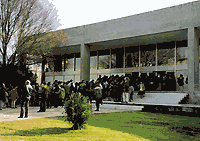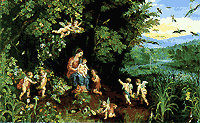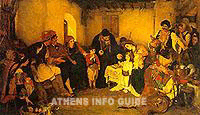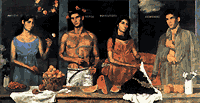
National Art Gallery
Alexandros Soutzos Museum
The National Art Gallery – Alexandros Soutzos Museum, is
the most important institution in Greece devoted to the subject
of the history of Greek art. The masterpieces decorating the halls
of the gallery give a complete picture of the aesthetic paths
and history of art in modern Greece.
When
the National Gallery was founded in 1900, it comprised 258 works
from the collections of the University of Athens and the Technical
University of Athens. The first curator was the painter Georgios
Iakovadis. One year later, the collection of Alexandros Soutzos
(107 paintings) were donated to the National Gallery.
Soutzos,
a lawyer and art-lover, had spent his fortune creating a large
art collection and the founding of a museum of painting. The National
Gallery was jointed together with Alexandros Soutzos’ gift
in 1954. The original collections were enriched by donations and
last will gifts of artists and Greek art-lovers as well as by
purchasers of important works. The donation of the Evripidis Koutlidis
collection was of great importance and completed the presentation
of the history of modern Greek painting (19th-20th century).
The
gallery’s collection, which now comprises of more than 9.500
paintings, sculptures and engravings, found its permanent home
in 1976 when the present building was opened. Construction began
in 1964 under the architects Fatouros, Milonas and Moutsopoulos.
It is a low building with two wings and it follows modern architectural
styles for public buildings.
Short
exhibitions of cultural interest are held in the first wing. In
the halls of the second and largest wing, most of the permanent
collection of paintings is on display. The outstanding collection
of sculptures from the 19th and the 20th century will be accommodated
in the Museum of Sculpture in Goudi.
 Priority
is given to modern Greek painting and the approach of art lovers
to the works of the most important Greek artists. Particular emphasis
has been given to the 19th and the first half of the 20th century,
while, due to the lack of space, later generations of artists
are preserved with only a few representative works. The small,
though remarkable, collection of 14th-20th century European paintings
is not permanently exhibited, depending on the space needed by
temporary exhibitions. Priority
is given to modern Greek painting and the approach of art lovers
to the works of the most important Greek artists. Particular emphasis
has been given to the 19th and the first half of the 20th century,
while, due to the lack of space, later generations of artists
are preserved with only a few representative works. The small,
though remarkable, collection of 14th-20th century European paintings
is not permanently exhibited, depending on the space needed by
temporary exhibitions.
The
permanent collection of Greek paintings extends to the first and
the second floor of the main wing. On the first floor, visitors
can see works from the 19th century and on the second floor, 20th
century works. The paintings are exhibited in chronological order
and in thematic units. Partitions divide the space into different
sub-units. This way, visitors gain a clear view of the development
of Greek painting and can admire the best examples of fine art
over the course of two centuries.
The
tour starts in the main hall on the first floor, on the right
of the entrance. Here are the oldest works of the collection,
including those of Domenikos Theotokopoulos, known in European
art as El Greco. The history of modern Greek art began with the
advent of painters from the Ionian islands who are represented
with several important paintings presented in a separate unit.
Exquisite
portraits, landscapes and historical scenes show the first years
of the Greek State (1832-63). The most important artist of the
time is Theodoros Vrizakis who illustrated the heroic moments
of the 1821 War of Independence while the three portraits by Nikolaos
Kounelakis, showing the family of the artist, are typical of the
potential of the art of portraits.
Some
of the most popular works were created by the academic painters
who studied in Munich in the 19th century. These are presented
in the unit “The Bourgeoisie and its Artists”. Main
representatives of the so-called Munch School, which dominated
art in the second half of the 19th century, are Nikiforos Litras,
Konstantine Volanakis, Nikolaos Gizis and Georgios Iakovidis.
 “The
Engagement of the Children” by Gizis, the most influential
and prestigious Greek painter of his time, stands out for its
maturity while his “Arts and its Spirits”, “Springs
Symphony” and “There Comes the Bridegroom”,
are splendid samples of the artist’s personal style with
symbolist implications. The portrait of “Lyssandros Kaftantzolgou”
by the great teacher Nikiforos Litras, is admirable for its psychological
analysis of the sitter. Works from the late 19th century, on display
in the rest of the hall, introduce visitors to the different atmosphere
of chromatic sensitivity inspired by Impressionism. “The
Port of Copenhagen” by Ioannis Altamouras stands out for
its pioneering spirit and lyricism. “The
Engagement of the Children” by Gizis, the most influential
and prestigious Greek painter of his time, stands out for its
maturity while his “Arts and its Spirits”, “Springs
Symphony” and “There Comes the Bridegroom”,
are splendid samples of the artist’s personal style with
symbolist implications. The portrait of “Lyssandros Kaftantzolgou”
by the great teacher Nikiforos Litras, is admirable for its psychological
analysis of the sitter. Works from the late 19th century, on display
in the rest of the hall, introduce visitors to the different atmosphere
of chromatic sensitivity inspired by Impressionism. “The
Port of Copenhagen” by Ioannis Altamouras stands out for
its pioneering spirit and lyricism.
20th
century painters are presented on the second floor. Innovation,
experimentation, special painting techniques and originality are
characteristic of these works, which all express the Greek spirit
through art. Famous artists in the unit “Towards a Greek
Modernism” are Konstantinos Parthenis and Konstantinos Maleas
who are considered the “Fathers of Greek Painting”.
The “Apotheosis of Athanassios Diodakis” by Konstantinos
Parthenis and “Kameni Islands of Santorini” by Konstantinos
Parthenis and Maleas reveal the genius and uniqueness of their
creators.
 The
mid-war is represented by artists of the so-called Generation
of the 30s. Important figures such as Spiros Papaloukas, Giannis
Tsarouchis, Diamantis Diamantopoulos, Giannis Moralis and Nikos
Hadjikyriakos-Ghikas perfectly harmonized with contemporary European
styles but also expressed Greece in art, thus widening all the
opportunities offered by the past, history, tradition, folk art
and modernism. The
mid-war is represented by artists of the so-called Generation
of the 30s. Important figures such as Spiros Papaloukas, Giannis
Tsarouchis, Diamantis Diamantopoulos, Giannis Moralis and Nikos
Hadjikyriakos-Ghikas perfectly harmonized with contemporary European
styles but also expressed Greece in art, thus widening all the
opportunities offered by the past, history, tradition, folk art
and modernism.
The
works of Nikos Hadjikyriakos-Ghikas, the main painter to adopt
cubism and the works of Giorgos Bouzianis with the unique expressionistic
language, perfectly express the modernistic tendencies of these
artists. Among the works created after the Second World War and
belonging to the last unit of the exhibitions, the most important
is the “Epitaphs” by Giannis Moralis, one of the most
accomplished Greek artists of the 20th century. The small hall
on the second floor has periodical exhibitions of selected modern
paintings from the gallery’s collection thus completing
the history of Greek painting.
 Giannis
Tsarouchis (1919-1989) Giannis
Tsarouchis (1919-1989)
Giannis
Tsarouchis (1919-1989) was a unique artist and intellectual.
He was raised in Athens from a middle-class background.
Very early on in his life he started to appreciate simple
working-class people for their authentic Greek character.
His ideas were mostly influenced by his teacher, Fotis
Kontoglou, who also introduced him to Byzantine art.
 Tsarouchis
gradually developed an eclectic style in his paintings.
He used sharp observation and managed to depict scenes
from everyday life in a monumental way. He loved Athens
with its small streets and the authentic people who lived
there. He also was a passionate photographer, capturing
the faces of ordinary people and scenes or anything that
would draw his attention around Athens. Tsarouchis
gradually developed an eclectic style in his paintings.
He used sharp observation and managed to depict scenes
from everyday life in a monumental way. He loved Athens
with its small streets and the authentic people who lived
there. He also was a passionate photographer, capturing
the faces of ordinary people and scenes or anything that
would draw his attention around Athens.
He
has photographed entire areas with neoclassical houses
that were later demolished, thus preserving a memory of
a lost world. He transferred those images into his paintings
and theatrical sets. All houses, coffee shops and scenes
from everyday life have an almost metaphysical dimension
in his work.
Among
his most important characteristic paintings are two of
the “Neon” coffee shop in Omonia Square where
he used to spend time himself. His house in Maroussi has
become a museum dedicated to his life and art.
|
 Opening hours and admission
Opening hours and admission
 50, Vassileos Konstantinou Avenue
50, Vassileos Konstantinou Avenue
 Evangelismos
Evangelismos 

|

